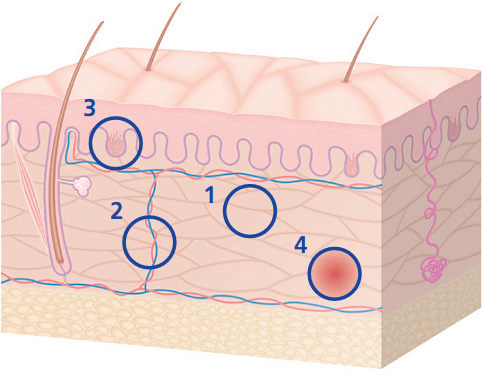As people’s awareness of health and environmental protection enhances, active matter derived from plants is getting more and more attention. Continue reading
Category Archives: Whitening and freckle elimination
NanoActive THC
NanoActive THC is a novel tetrahydrocurcumin nanoliposome preparation (NanoLiposomal THC).
Product Name: Nano Liposomal THC; Nanoactive THC; BioaActive THC; BioActive Tetrahydrocurcuminoids; NanoActive Tetrahydrocurcuminoids; Water Soluble Tetrahydrocurcuminoids; Fat Soluble Tetrahydrocurcuminoids
CAS: 36062-04-1
Description:Tetrahydrocurcumin (ultra pure whitening element) is a natural functional whitening ingredient extracted from the roots of Ginger Curcuma longa.Thanks to its potent activity against tyrosinase, the whitening effect of this product is better than that of arbutin; it can effectively inhibit the formation of oxygen free radicals as well as eliminate the formed free radicals. Featured with significant antioxidant effects, such as anti-aging of human skin, skin repair, lightening pigments, clearing freckles, etc., it is widely applied in various skincare products for whitening, freckle eliminating, and anti-oxidation. Tetrahydrocurcumin is hardly soluble in water while easy to be oxidized and discolored, which limits its application in cosmetics. Nano actives with a particle size of less than 30 nm developed by nano-transmission system (NDS) enable tetrahydrocurcumin to be steadily wrapped in nano-carriers, greatly improving the absorption efficiency and bioavailability. This overcomes the original defects and maintain the advantages with a more convenient and wider range of uses.
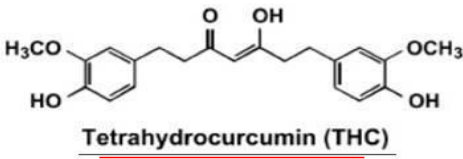

Tetrahydrocurcumin
Skincare Effect
Tetrahydrocurcumin (ultra pure whitening element) is a perfect comprehensive natural ingredient for whitening and a high-purity turmeric extract that can inhibit tyrosinase at a extremely low concentration. Its whitening effect is several times that of common whitening active ingredients such as arbutin, licorice and vitamin C. It also has a unique bio-protective function, which can provide skin with double anti-oxidation protection, helping the skin to resist the damage of UV rays and inflammation. Safety tests show that it has no side effects of any irritation or sensitization on human skin, and can safely and effectively perform the function of natural whitening and skin brightening. Compared with the western medicine phenylbutazone, ultra-pure whitening element can achieve the same effect with half of its dose. Compared with curcumin and its analogues, ultra-pure whitening element is more effective for acute and subacute inflammation. The inhibition of ultra-pure whitening element against lipoxygenase, collagenase and hyaluronidase reduces the formation of skin inflammation including erythema, while also reducing wrinkles, maintaining skin elasticity and anti-aging.While whitening the skin, it can also improve the skin texture, increase the gloss, and make the skin look healthy and bright. Therefore, ultra-pure whitening element is a comprehensive natural extract for whitening. It is a natural whitening material with comprehensive functions such as resisting UV, anti-oxidation, inhibiting inflammation and tyrosinase, lightening melanin, etc. In comparison with similar products in the market, its whitening effect of lightening melanin is excellent, and it also has many other skin bioprotective effects, which is an advantage that other raw materials cannot match. Widely applied, it is a whitening additive recognized by famous cosmetics companies around the world.

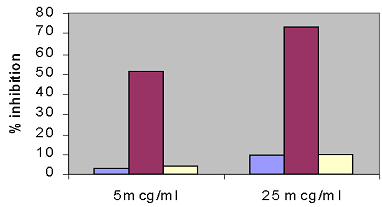
![]()

Tetrahydrocurcumin can effectively eliminate oxygen free radical

Tetrahydrocurcumin has significant anti-inflammatory effects

Experiments showed tetrahydrocurcumin’s excellent whitening effect
Features
- NanoActive THC solves the problem of tetrahydrocurcumin’s tendency to be oxidized and discolored.
- NanoActive THC uses FDA GRAS materials for high safety.
- NanoActive THC has a good stability towards heat, pH and shearing and is easy to use.
- NanoActive THC greatly improves the stability and bioavailability of tetrahydrocurcumin.
- NanoActive THC improves the stability of other actives in the product and promotes absorption.
- NanoActive THC is 100% water soluble and 100% oil soluble (amphiphilic), allowing a wide range of uses.
Applications
- Inhibit melanin synthesis, reduce pigmentation and whiten your skin
- Eliminate free radicals and confront skin aging
- Promote collagen synthesis, improve skin thickness and elasticity, remove wrinkles, and firm your skin
- Help wound healing and reduce scars
- Anti-glycosylation
- Cure acne and reduce acne marks.
- Anti-bacteria, diminish inflammation and sensitization, and provide analgesic effects
- Prevent scarring and fibrosis
Use: Add it at room temperature. You may heat it to over 40℃ to speed up the dissolution. Recommended dosage: 1-5%. The optimum pH range of the system is 3.0-6.5, and the finished product should be protected from direct exposure to sunlight (using opaque packaging). It is recommended that UV absorber be added to day care products.
Storage : keep it away from light at a temperature below 25℃.
NanoActive SA
Nanoactive SA is a novel salicylic acid nanoliposome preparation (NanoLiposomal SA).
Product Name: Nano Liposomal SA; Nanoactive SA; Nano Active Salicylic Acid; Water Soluble Salicylic Acid; Fat Soluble Salicylic Acid; BioActive Salicylic Acid CAS: 69-72-7
Description: Salicylic acid is Beta Hydroxy Acid, also known as BHA or B softening fruit acid, which is found in willow barks, wintergreen leaves and sweet birches in nature. Salicylic acid has an excellent ability to clear acne, exfoliate, and clean pores with high safety. Salicylic acid can also lighten pigment spots, shrink pores, remove fine wrinkles and improve aging caused by sun exposure, thus becoming the new favor of skincare products. However, salicylic acid is hardly soluble in water and is highly irritating, which limits its application. The Nano SA actives, developed with the nano-transmission system (NDS), has a particle size of less than 30nm, which enables salicylic acid to be steadily encapsulated in nano-carriers, greatly improves the absorption efficiency and bio-availability. This overcomes the original defects and maintain the advantages with a more convenient and wider range of uses.

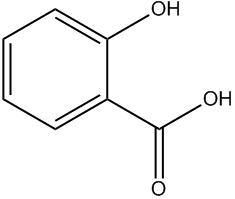
White willow Salicylic acid
Features:
- NanoActive SA uses FDA GRAS grade materials for high safety
- NanoActive SA is stable to heat, pH and shearing, so it is convenient to use.
- NanoActive SA overcomes the original shortcomings of salicylic acid while maintaining the advantages, and improves bioavailability
- NanoActive SA can improve the stability of other active matters in the product and facilitate absorption
Efficacy:
- It increases the absorption of your skin. When combined with other skincare ingredients, salicylic acid increases the absorption of actives by the skin.
- It clears pore blockage. This gentle acid can decomposes blackheads and whiteheads by strip the outer layers of your skin.
- Exfoliate and cleanse. Salicylic acid is a keratolytic agent that not only has exfoliating effect, but also has anti-bacterial effect. At the same time, it can remove dead cells from the skin and prevent the acne caused after the mix between dirt and sebum.
- It resists dryness. Salicylic acid softens keratin and helps protect skin from dryness.
Use: Add it at room temperature. You may heat it to over 40℃ to speed up the dissolution. Recommended dosage: 1-5%. Divalent or trivalent metal ions such as iron must be avoided in the system.
Storage: Keep it away from light at a temperature below 25℃.
NanoActive RAL
Nanoactive RAL, INCI name: Retinal, CAS: 116-31-4.
Product Name: Nanoactive RAL, BioaActive Retinaldehyde; BioActive Retinal; Soluble Retinal; Soluble Retinaldehyde;Nano Liposomal
Nanoactive RAL is a novel retinal nanoliposome formulation (NanoLiposomal RAL).
A new liposome preparation. RAL has the characteristics of retinoic acid in the skin, and is better tolerated than retinoic acid. It directly interacts with protein receptors in cells, stimulates epidermis to accelerate regeneration, increases the thickness of the stratum corneum, and makes the skin tighter and more orderly. It also accelerates the production of collagen in the dermis layer, prevents the damage of UV to collagen, inhibits the increase of MMP caused by UV, and makes the skin more elastic; the unique aldehyde-based structure has a very good effect on P. acnes, etc., and effectively improves acne skin. Large amounts of retinal, retinol, retinol retinate (15498-86-9), HPR(893412-73-2) and other Vitamin A kind products of pharmaceutical grade are available.
Description:
Retinaldehyde (RAL), also known as vitamin A aldehyde, is a derivative of retinol after oxidation. It is formed by oxidative cleavage of β-carotene. If reduced, retinol can be attained; If oxidized, retinoic acid can be attained.Retinoic acid。”. The role of retinoic acid (Vitamin A) in skin diseaseis very extensive, but due to local irritation, its clinical application is limited to some extent.Retinaldehyde is an intermediate metabolite of natural retinoic acid and has similar biological activity as retinoic acid. But the skin is significantly more tolerant to retinoic acid.
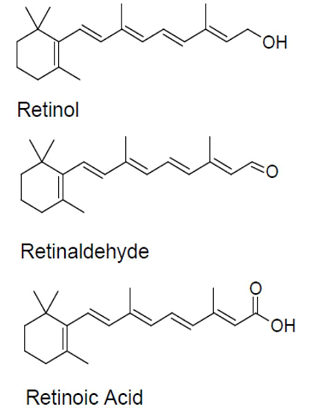
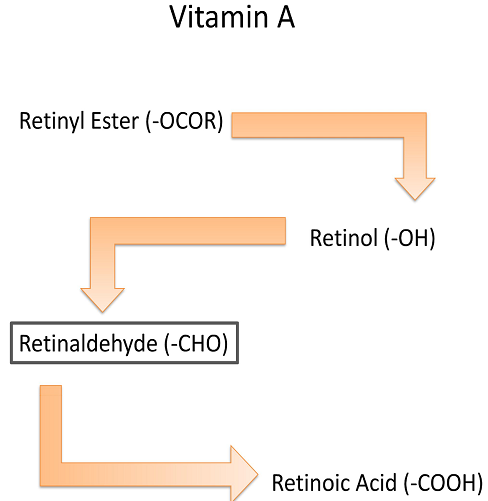
The main forms of vitamin A and their interconversion
Retinal has many target on the skin. It can be used as a skin care product to produce a variety of effects such as anti-aging, skin rejuvenation, whitening, anti-wrinkle, acne, keratin, etc. It is an emerging high-efficiency natural active substance. Retinal is hardly soluble in water while easy to be oxidized and discolored, which limits its application in cosmetics. Nano actives with a particle size of less than 30 nm developed by nano-transmission system (NDS) enable retinals to be steadily wrapped in nano-carriers, greatly improving the absorption efficiency and bioavailability. This overcomes the original defects and maintain the advantages and enables a more convenient and wider range of uses.
Skin care effect
The large use of non-physiological doses of exogenous retinoic acid can cause an overload of the retinoic acid-dependent pathway in the skin, causing adverse reactions such as skin irritation. RAL is a natural metabolite of retinol and a direct precursor of retinoic acid, and it also has similar biological activity to retinoic acid. The advantage of RAL compared with retinoic acid is its multi-directional metabolism, that is, the excess RAL can be rapidly reduced to retinol, then stored and inactivated in the form of retinol, and this “reverse metabolism” is not present in retinoic acid. After it is absorbed by the skin, most of it is converted to retinol vinegar stored for slow release, and a small amount of RAL is oxidized to retinoic acid by keratinocytes in differentiation-dependent manner, while a very small amount of retinoic acid is can exert significant biological effects in cells. This can avoid skin adverse reactions caused by high doses of retinoic acid. Clinical observations also show that topical RAL creams are well tolerated compared with retinoic acid and can be applied to sensitive areas. The topical RAL cannot absorbed by human blood. The levels of various vitamin A acids in the blood also cannot be affected.
RAL needs to be activated by the conversion of enzymes in keratinocytes to retinoic acid, so RAL has similar biological activity as retinoic acid. One of the indicators of retinoic acid activity is to induce the expression of retinoic acid binding protein (CRABP-2) in cells. External RAL can evidently induce the expression of CRABP-2 mRNA and protein. The topical natural retinoic acidcan also induce the expression of nuclear receptor in retinoic acid . Like retinoic acid, RAL also functions to regulate cell proliferation and differentiation. It can increase epidermal DNA synthesis, increase epidermis thickness, induce 50kD keratin, and reduce 7OkD keratin mRNA expression. Inducing positive keratinization, reducing 65kD keratin mRNA expression, and increasing filaggrin and loricin mRNA expression. In addition, RAL is also involved in the regulation of neovascularization in the skin, inhibiting the production of vascular endothelial growth factor by keratinocytes. It can repair the elastic fibers and collagen damage induced by UVA. RAL is also capable of dissolving acne and the direct sterilizing effect towards propionibacterium acnes. Natural retinoic acid play an important role in epidermal differentiation, dermal remodeling and curing skin inflammation. Retinaldehyde as an important intermediate metabolite of natural retinoic acid has both biological activity similar to that of retinoic acid and is well tolerated by the skin, thus it is given wider application in cosmetics.
Retinaldehyde can repair elastic fiber and collagen loss caused by UV:
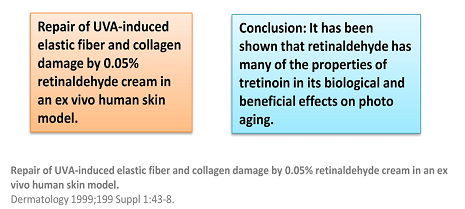
Retinaldehyde prevents skin aging caused by ultrasound and fluid
technology:
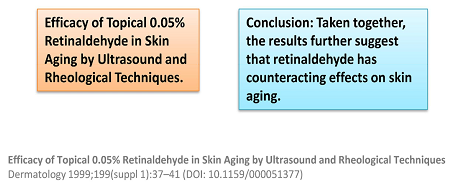
Retinaldehyde can effectively improve skin photoaging symptoms:
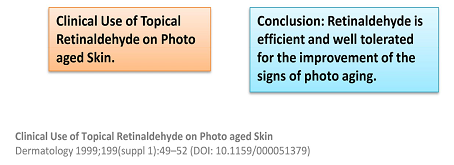
Retinaldehyde and retinal are well tolerated, while retinoic acid is more irritating
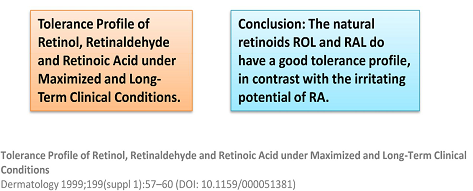
Retinaldehyde can effectively inhibit epidermal melanin
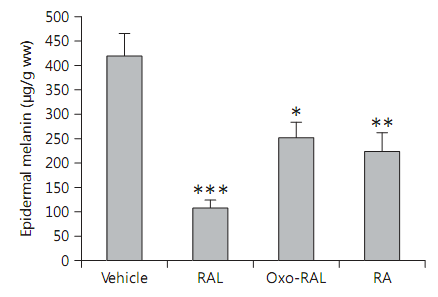
Features
- NanoActive Retinaldehyde uses FDA GRAS grade materials for high safety
- NanoActive Retinaldehyde has good heat, pH and sheer stability and is easy to use.
- NanoActive Retinaldehydegreatly enhances the stability and bioavailability of retinal
- NanoActive Retinaldehyde can improve the stability of other active matters in the product and facilitate absorption
- NanoActive Retinaldehyde is 100% water soluble and 100% oil soluble, allowing a wide range of uses.
Applications
- Wrinkle repairing: promote collagen and hyaluronic acid synthesis, increase skin thickness and elasticity, repair the wrinkle and firm the skin.
- Whitening and freckle removing: inhibit melanin synthesis, reduce pigmentation, whiten the skin and remove the freckle.
- Anti-aging: anti-oxidation, anti-skin-aging
- Skin-refreshing: renewal of keratin, refresh the skin.
- Acne Treatment: sterilizing propionibacterium acnes and streptococcus, etc., treating acne and removing acne marks
- Curing of skin photoaging
Use: Add it at room temperature; recommended dosage: 1-5% The optimum pH range of the system is 3.0-6.5, and the finished product should avoid direct exposure to sunlight (using opaque packaging). It is recommended to add UV absorber to day care products.
Storage: keep it away from light at a temperature below 25℃.
Nano phenethyl resorcinol (NanoActive 377)
Nano phenylethyl resorcinol (NanoActive 377) is a new type of phenethyl resorcinol nanoliposome preparation (NanoLiposomal 377).
Product Name: Nano Liposomal 377; BioActive Phenylethyl Resorcinol; NanoActive 377; NanoAcive Phenylethyl Resorcinol; Water-Soluble 377; Fat-Soluble 377 CAS: 85-27-8
Description: Phenylethyl resorcinol is a new high-efficiency skin whitening agent derived from silver pine, which has ultra-strong potential whitening effect: In Vitro Experiments have also proved that it is ten or even hundred times stronger than that of VC. And it has also been clinically proven to its whitening ability is equivalent to that of hydroquinone. The most important thing among it is that the whitening speed is fast and is favoring to consumers. After more than ten years of continuous studying of the nature and safety of these raw materials, this emerging high-efficiency natural active substance is gradually getting permission from various countries and gradually used in cosmetics. Phenylethyl resorcinol is poorly soluble in water and susceptible to oxidization and discoloration, which limits its application in cosmetics. Nano actives with a particle size of less than 30 nm developed by nano-transmission system (NDS) enable phenylethyl resorcinol to be steadily wrapped in nano-carriers, greatly improving the absorption efficiency and bioavailability. This overcomes the original defects and retains the advantages with a more convenient and wider range of uses.
Phenylethyl resorcinol


Skin care effects
Phenylethyl resorcinol can effectively inhibit melanin synthesis by acting on multiple targets of the melanin synthesis pathway, thereby achieving whitening and brightening effect. Super antioxidant, effectively removes harmful free radicals from the skin, prevents wrinkles caused by aging and free radicals.

SymWhite 377 effectively inhibits the activity of B16 melanoma to form melanin, which is 210 times the kojia acid, and 32 times the arbutin!
Tyrosinase inhibitory activity

Whitening test–skin model

Clinical trial (unirradiated skin)
Features
- Added NanoActive 377 to the formula and the color remained the same.
- NanoActive 377 uses FDA GRAS grade materials for high safety
- NanoActive E has good heat, pH and shear stability and is easy to use
- NanoActive 377 greatly improves the stability and bioavailability
- NanoActive 377 can improve the stability of other active matters in the product and facilitate absorption
- NanoActive E is 100% water soluble and 100% oil soluble (amphiphilic) for a wide range of application.
Applications
- Inhibits melanin synthesis, reduces pigmentation and whitens the skin
- Eliminate free radicals and prevent skin aging.
- Reduce acne marks
The market claims:
- Originated from the essence of evergreen conifer
- Is a powerful whitening ingredient
- Effectively evens skin tone, leaving skin quickly regaining whiteness, clearness, and regaining the bright skin tone of young skin.
- Lightens dark spots, and the skin becomes bright after use
- A powerful antioxidant that can be used to fight harmful free radicals that cause skin aging
- Mild texture, no side effects that irritate the skin
- Ultra-micro-nano wrapping technology, effective penetration and does not change color
Use: add it at room temperature. Heat it to above 40℃to speed up the dissolution. Recommended dosage: 0.1-5%. The optimum pH range of the system is 3.0-6.5, and the finished product should be protected from direct sunlight (using opaque packaging). It is recommended to add UV absorber to day care products.
Storage: Keep it away from light at a temperature below 25℃.
NanoActive RES
Nanoactive Res is a novel resveratrol nanoliposome preparation (NanoLiposomal Resveratrol).
Product Name: Nano Liposomal Res, Nanoactive Res; BioActive Resveratrol; NanoActive Resveratrol CAS: 501-36-0
Description: Resveratrol (“Res”) is a non-flavonoid polyphenolic compound. A Japanese called Tokaoka was the first one who obtained it by separating it from the roots of Veratrum granginorumin 1940. With the in-depth study of resveratrol, it has been shown that resveratrol has a wide range of activities such as anti-cancer, anti-oxidation, anti-bacteria and anti-inflammation which can be broadly used in medicine, health care products, food, cosmetics and other fields. Resveratrol has many targets in the skin, so it can be used as a skincare product to produce whitening, anti-wrinkle, anti-bacteria, anti-inflammation, acne curing and anti-aging effects. It is an emerging natural active substance with high efficiency. However, resveratrol is hardly soluble in water while easy to be oxidized and discolored, which limits its application in cosmetics. The nano actives, developed with the nano-transmission system (NDS), has a particle size of less than 30nm, and enables the resveratrol to be steadily encapsulated in nano-carriers, greatly improving the absorption efficiency and bioavailability. This overcomes the original defects while maintaining the advantages with a more convenient and wider range of uses.


Resveratrol

Number of papers on resveratrol in PUBMED over years

Resveratrol can effectively prolong life span
Skincare effect
Resveratrol is a natural antioxidant present in plants. Its antioxidant capacity is 20-50 times that of L-C. If applied simultaneously with L-C, the effect will be multiplied. Resveratrol inhibits collagenase, reduces collagen degradation, promotes collagen proliferation, and firms skin. Resveratrol allows cells to enhance their self-defense enzymes, thereby repairing damaged DNA, while effectively inhibiting oncogenic proteins produced by UVB exposure. Resveratrol can effectively inhibit melanin synthesis by reacting with multiple targets required for melanin synthesis, thereby achieving whitening and brightening effect.
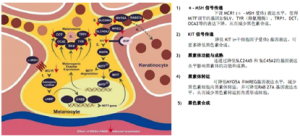
Resveratrol inhibits melanin synthesis through multiple targets
Features
- NanoActive RES uses FDA GRAS grade materials for high safety
- NanoActive RES is stable to heat, pH and shearing, so it is convenient to use.
- NanoActive RES greatly improves the stability and bioavailability of resveratrol
- NanoActive RES can improve the stability of other active matters in the product and facilitate absorption
- NanoActive RES is 100% water soluble and 100% oil soluble (amphiphilic), allowing a wide range of uses.
Applications
- Promote collagen synthesis, improve skin thickness and elasticity, remove wrinkles, and firm your skin
- Inhibit melanin synthesis, reduce pigmentation and whiten your skin
- Eliminate free radicals and confront skin aging
- Promote wound healing and reduce scars
- Cure acne and reduce acne marks.
- Anti-bacteria, diminish inflammation and sensitization, and provide analgesic effects
- Prevent scarring and fibrosis
Use:Add it at room temperature. You may heat it to over 40℃ to speed up the dissolution. Recommended dosage: 1-5%. The optimum pH range of the system is 3.0-6.5, and the finished product should be protected from direct exposure to sunlight (using opaque packaging). It is recommended to add UV absorber to day care products.
Storage: Keep it away from light at a temperature below 25℃.
Experimental proof
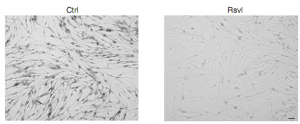
Resveratrol inhibits intracellular melanin synthesis

Resveratrol tyrosinase activity is superior to kojic acid

Low concentration of resveratrol (0.001%) can reduce B16F10 cell melanin by 50%

Two-week application can provide noticeable whitening effect

Resveratrol has obvious anti-wrinkle effect

Resveratrol (0.001%) is effective in treating acne


Before RES treatment After RES (0.001%) treatment
